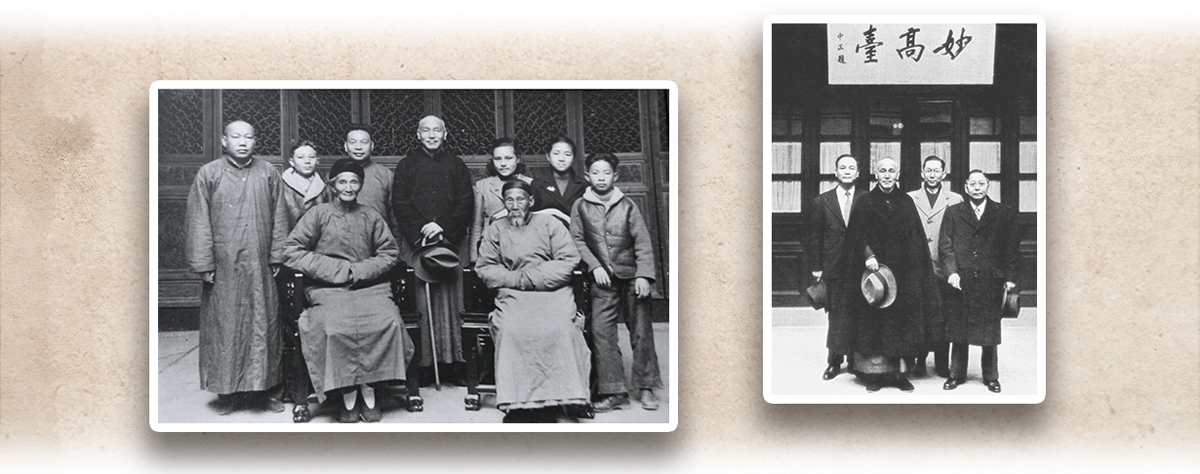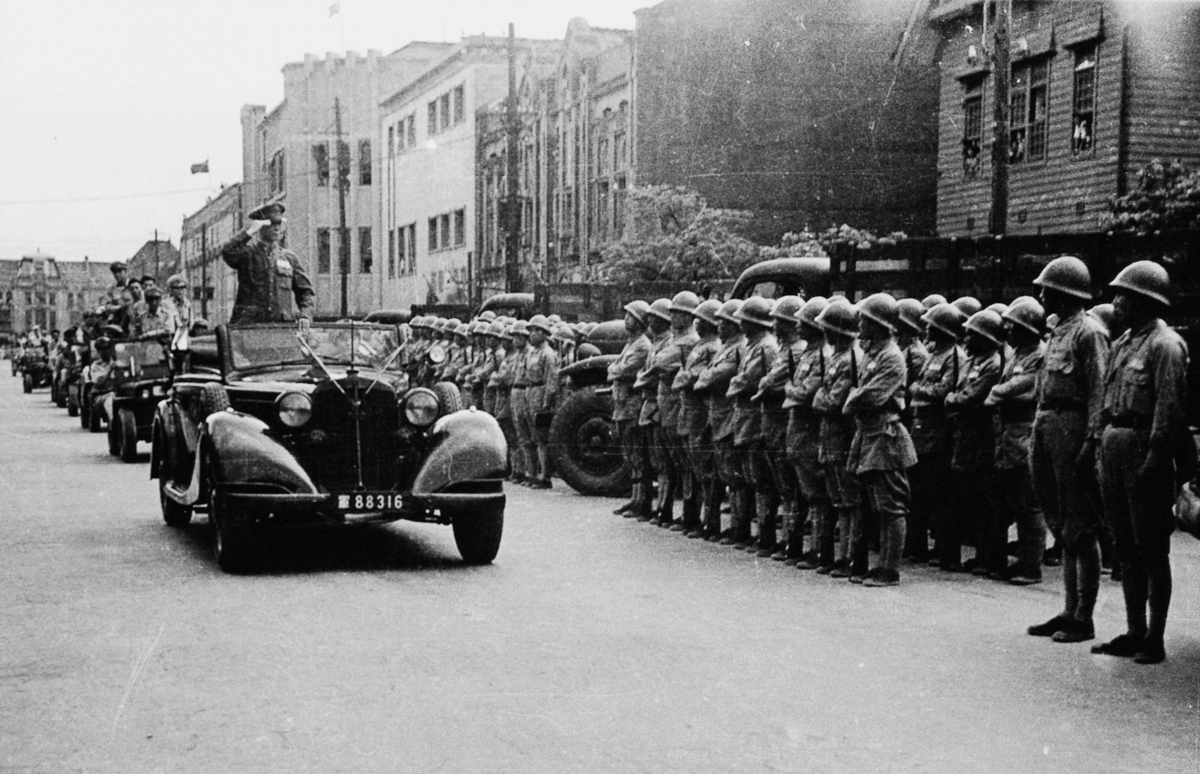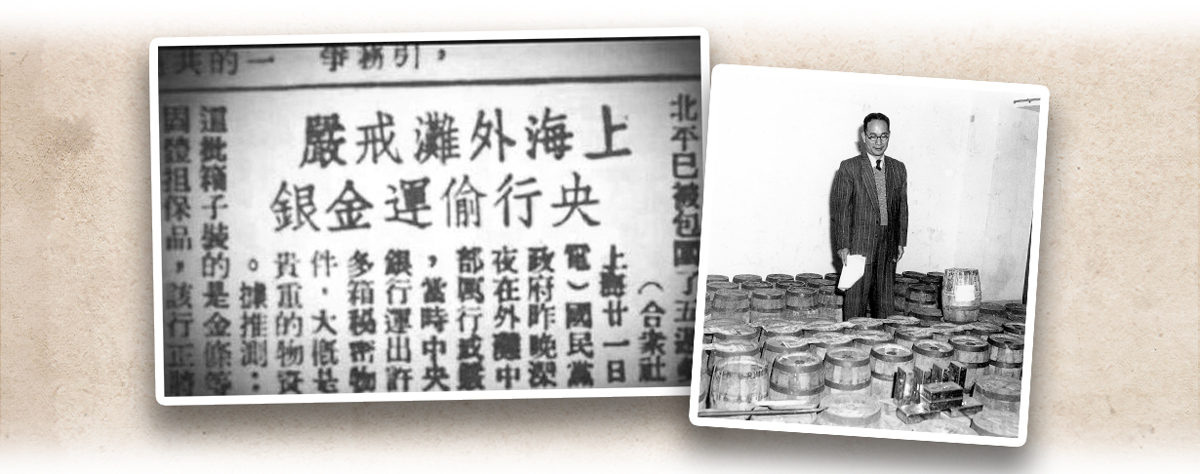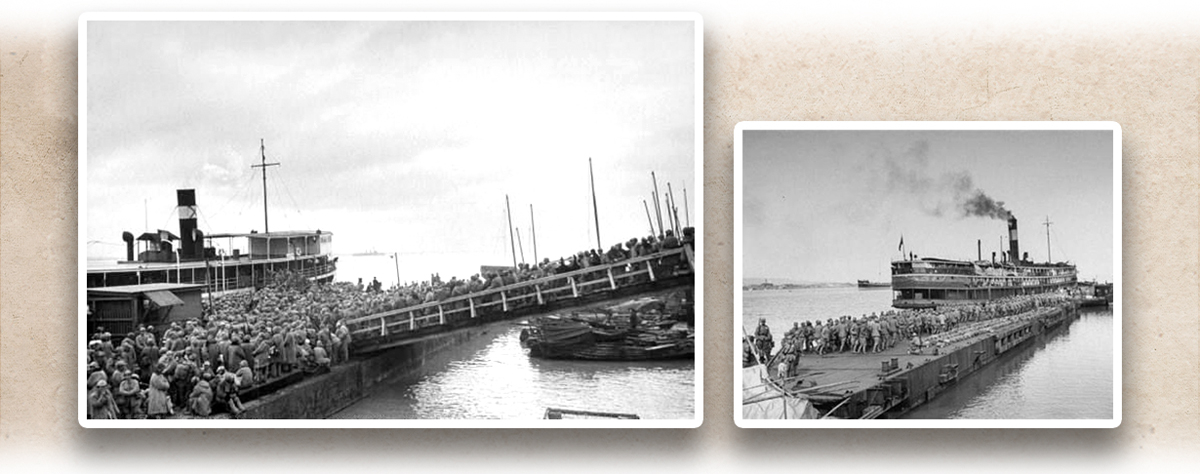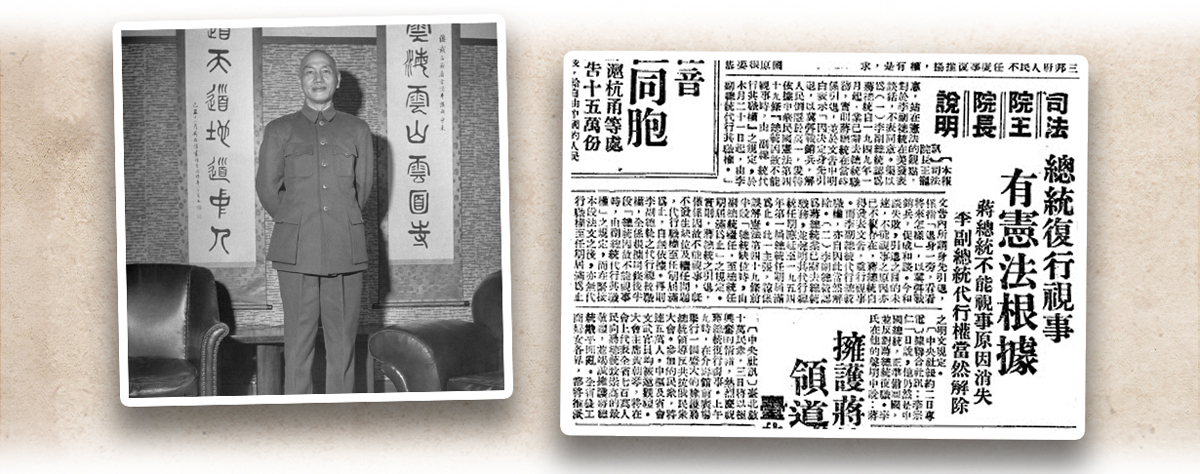After the founding of the People’s Republic of China, the People’s Liberation Army (PLA) continued to advance nationwide, while the National Army (NA) gradually retreated. During the Chinese Civil War, Taiwan (台灣) was relatively stable and rarely affected by the war. In January 1949, the National Government appointed Chen Cheng (陳誠) as Chairman of Taiwan Provincial Government. At the same time, a large amount of gold, US dollars, and cultural relics were shipped to Taiwan from the mainland. On 7 December 1949, the National Government announced its relocation to Taiwan, and continued to maintain the banner of the Republic of China, with Taipei (台北) as the seat of government. At that time, Acting President Li Zongren (李宗仁) flew to the United States and did not return, resulting in Chiang Kai-shek (蔣介石) making a comeback as President on 1 March 1950. After that, the regime was held by Chiang Kai-shek and his son Chiang Ching-kuo (蔣經國) for a long time. After the relocation to Taiwan, the National Government garrisoned the islands of Taiwan, Penghu (澎湖), Kinmen (金門), and Matsu, which were collectively known as “the Taiwan area”. Initially, the Kuomintang of China (KMT, 中國國民黨)’s situation in Taiwan was in jeopardy. It was the Seventh Fleet sent by the United States when the Korean War broke out in June 1950 that help defend the Taiwan Strait and save the KMT. The KMT learned that neglecting the people’s livelihood, especially in rural areas, could be very costly. It thus carried out land reforms and developed the regional economy after retreating to Taiwan. The division of governance between the two sides of the Taiwan Strait continues to this day.
Footnotes:
1. In December 1947, the National Revolutionary Army (NRA) was renamed the Republic of China Armed Forces, and was generally called the National Army (NA, 國軍﹝Guojun﹞in Chinese).
2. In May 1948, the Nationalist Government was renamed the Government of the Republic of China, and was generally called the National Government (國民政府﹝Guominzhengfu﹞or 國府﹝Guofu﹞in Chinese).
|
|
Apart from its own mistakes, were there any other objective factors causing the KMT to lose political power on the mainland in a short period of time after reunifying the country? |
|
|
See answer below. |
The KMT adopted the Constitution of the Republic of China at the end of 1947. It held the National Assembly in 1948, appointing Chiang Kai-shek as President and Li Zongren as Vice President. The photo shows the President and Vice President taking the oath of office in Nanjing (南京) on 20 May 1948. President Chiang and Vice President Li are sitting 13th and 14th from the left in the first row. Meanwhile, the Chinese Civil War was raging and the NA constantly found itself frustrated on the front line, exacerbating the KMT’s situation.
In early 1949, Chiang Kai-shek announced his resignation and returned to his hometown Fenghua (奉化), Zhejiang Province (浙江). Left: Chiang with relatives in his hometown. Right: Chiang meeting Sun Ke (﹝孫科﹞, son of Sun Yat-sen﹝孫中山﹞, first from the right) and others in his hometown. Chiang resigned ostensibly, but still held the KMT’s military and political power in his hands. He met with military and political dignitaries many times in his hometown to deploy the relocation of the Government to Taiwan.
After Chiang Kai-shek resigned, Li Zongren (left) took over as Acting President. On 1 October 1949, the People’s Republic of China was founded, and the KMT’s rule on the mainland was almost completely disintegrated. In November, Li announced that the military and political affairs would be entrusted to Premier Yan Xishan (閻錫山, right) on the grounds of recuperation. He then flew to Hong Kong before going to the United States the following month and did not return.
From January to December 1949, Chiang Kai-shek’s close general Chen Cheng served as Chairman of the Taiwan Provincial Government and arranged for the move of the National Government to Taiwan. The photo shows Chen, the Chairman of the Taiwan Provincial Government, reviewing the troops at the National Day ceremony on 10 October.
From November 1948 to October 1949, the KMT secretly transported most of the treasury gold stored in the Central Bank from Shanghai to Taiwan, which was a critical move on Taiwan’s future economic development. Left: a newspaper report on the secret gold transportation. Right: large quantities of gold shipped to Taiwan.
From 24 to 27 October 1949, more than 9,000 PLA soldiers crossed the sea from Fujian Province (福建) to attack Kinmen, but most of them were annihilated by the NA. This battle prevented the PLA from further crossing the Taiwan Strait for the time being, and gave the KMT some breathing room, which had an important impact on the long-term separation of the two sides. Left: during the Guningtou Battle (古寧頭戰役) on Kinmen Island, the NA capturing a large number of PLA soldiers. Right: Chiang Kai-shek inspecting Kinmen in January 1952. Since 1949, Kinmen has been the front line of confrontation between the KMT and the Chinese Communist Party (CCP, 中國共產黨). Two large-scale artillery battles broke out in 1954 and 1958 respectively.
In 1949, a large number of NA soldiers withdrawing from the mainland to Taiwan by ship.
On 7 December 1949, the National Government announced its relocation to Taiwan, and on 1 March of the following year, Chiang Kai-shek announced his reinstatement. Left: Chiang in January 1950. Right: On 3 March 1950, Taiwan’s Central Daily News reported Chiang’s reinstatement.
Just as the PLA deployed to attack Taiwan, the Korean War broke out on 25 June 1950, marking a turning point in the situation of the Taiwan Strait.
When the Korean War broke out in June 1950, the United States sent its Seventh Fleet into the Taiwan Strait, preventing the PLA from crossing the sea to attack Taiwan and allowing the KMT to secure its position in Taiwan. Left: the US Seventh Fleet in the Taiwan Strait in 1950. Right: Chiang Kai-shek receiving the US Commander Douglas MacArthur at the Taipei Airport on 31 July 1950.
The US President Harry S. Truman had been indifferent to the Chiang Kai-shek Administration, and stood aloof when the NA suffered a crushing defeat in the later stage of the Chinese Civil War. When the Korean War broke out in June 1950, the Democratic People’s Republic of Korea (North Korea, part of the Soviet-led socialist camp) quickly seized most of the Republic of Korea (South Korea, part of the American-led capitalist camp). If South Korea fell, Japan would be at risk. Truman was worried that the communist forces would take control of East Asia and therefore changed the policy to intervene by force. He sent the Seventh Fleet to protect Taiwan and reinforce the KMT, and formed the United Nations Command with the US military as the main force led by the famous general MacArthur. It launched a counterattack on the North Korean army and reached the Yalu River (鴨綠江). This threatened the newly established People’s Republic of China. In October 1950, Peng Dehuai (彭德懷) led the army (in the name of “Chinese People’s Volunteer Army”) into the Korean Peninsula to engage the United Nations Command. An armistice was declared in July 1953. The Korean War enabled the KMT’s situation to turn the corner and gradually consolidate its rule in Taiwan, which became an important turning point in the long-term separation of the two sides of the Taiwan Strait. In the last paragraph of Kuo Ting-yee’s Outline of Modern Chinese History, the author noted: “In a private conversation with an important person in Taiwan, I was told that the Korean War was the Xi’an Incident (西安事變) of the KMT. The Xi’an Incident saved the Chinese Communist Party (中國共產黨) and the Korean War saved the KMT.”
|
|
Apart from its own mistakes, were there any other objective factors causing the KMT to lose political power on the mainland in a short period of time after reunifying the country? |
|
|
There were political, economic, military, and diplomatic factors contributing to the failure of the KMT, and it is thus an academic issue worthy of discussion. For subjective factors, one could argue that it was because the KMT represented the bureaucratic bourgeoisie and sought benefits for landlords and capitalists while neglecting the well-being of the poor in the rural areas. The lax internal organisations, numerous cliques, misguided military command, and low morale made it difficult to unite dissidents in the face of the internal and external challenges. All these issues were like fatal chronic diseases to the KMT. However, from a macro perspective of Chinese history, there are also objective factors for its short life. In view of the rise and fall of China’s previous dynasties, it is difficult to escape the rule of “separation after long-term unification, and unification after long-term separation” under the autocratic dynasty based on the small-scale peasant economy. In history, most of the dynasties that unified previous separated regimes were short-lived: the Qin dynasty (秦朝) lasted for only 15 years after the end of the Spring and Autumn Period and the Warring States; the Western Jin dynasty (西晉), which ended the separation of the Three Kingdoms, lasted for only 51 years, or only 36 years after the destruction of the Wu State (吳國); the Sui dynasty (隋朝), which unified the Northern and Southern dynasties, only lasted for 38 years, or only 30 years after the annihilation of the Chen Kingdom (陳朝); the Yuan dynasty (元朝), which annexed the dynasties of Xia(夏), Jin (金), and Song (宋), remained 98 years, or 89 years after the destruction of the Southern Song dynasty (南宋); the Republic of China, which ended the war between warlords by the Northern Expedition, lasted only 22 years. As soon as the division ended and reunification was achieved, the historical burden of the prolonged wars was too heavy to overcome. On the contrary, those who inherited the short-lived reunification often remained longer, such as the Han dynasty (漢朝) after the Qin dynasty, the Tang dynasty (唐朝) after the Sui dynasty, and the Ming dynasty (明朝) after the Yuan dynasty. This theory may not be a “law” and the phenomenon involved has not been scientifically examined. Yet, historians must take this as reference in great details. |
Source of most photos used in this feature piece: Fotoe.






